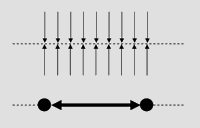
spatial dimensions
The structural axis relates the surroundings to itself
the formal axis represents a
relation between two points.
[Abb. 68]

temporal dimensions
The pre-temporal axis: on a predefined grid streets develop as axes.
The contemporal axis: from an existing urban fabric
an axis developes outwards.
The post-temporal axis: into an existing, usually inordinate fabric
an axis is breached in.
[Abb. 70]
In his 1929 published thesis 'The Axis in Architecture' Wilhelm Rave is reasoning:
'One speaks of a line or bar, a ray or energy, a motif or symbol, and understands the axis as is, even without a given explicit definition or an attempt to define.'
(Rave 1929: 6)
Even though almost everybody has an idea about what an axis is, Rave shows and explains an impressing number of scientific classifications about the architectural axis.
Thence, if the different meanings of an axis is common knowledge and there already exists a scientific treatise on the architectural axis, why another occupation with the axis? As a matter of fact, the axis is not only an architectural but also a significant urbanistic element, which is hardly dealt with. There is no general occupation, and even more awkward: no occupation with single examples, showing the importance of the urban axis.
And yet, no planning element or urban design pattern has been employed that often throughout the history of urban design. Since the 'invention' of the central perspective in the Renaissance it belongs to the basic repertoire of western urban design; today we identify it for example in Brasília, Paris, and Washington. At the same time, no urban design pattern became suspicious the way the axis happened to be. The still enormous political impact of the national socialist project for the 'Great North–South–Axis' in 1940s Berlin makes today's planners avoid any axial figure within the capital planning of reunited Berlin; they rather employ the metaphoric pattern of a strip that binds together the East and the West of the formerly separated city, as we see with Axel Schulthes and Charlotte Frank's winning project of the urban design competition for the federal government district in Berlin 1993 (cf. Zwoch 1993: 118). However, there are scruples as well in other cities and countries; few professionals use the axis in their urban designs as it is regarded banal, old–fashioned or martial, even though it might suit best a specific urban situation.
This thorough denial of a certain design pattern seems to be mistaken, after all when this pattern has been proofed valuable throughout history. Thus, this essay wants to establish anew an occupation with the axis in the urban fabric and seeks to solve resentments and misunderstandings. At the same time this paper should be part of a new profound design teaching, stressing the idea that modern urban design cannot be executed without knowledge about basic urban design patterns, their history, and their reception throughout time (cf. Rave 1929: 5; Steenbergen et al. 1996: 9f.).
To this end this essay undertakes to create a terminology to communicate about the axis in urban design. What is an axis, what different kinds exist, how were they developed, and what functions do they have? Apart from introduction and conclusion this essay consists of three main chapters. The first comprises a general introduction into the features of the axis, without necessarily being architectural. The second compasses an occupation with the architectonic–urbanistic aspects of the axis starting with the distinction between organizing element and transition space up to the actual design of axes. Within the third chapter the general and urbanistic findings are summarized to eventually postulate the dimensions of the axis in urbanism: space, time, and function.
Rave, Wilhelm: Die Achse in der Baukunst. TH Berlin (Diss.), 1929.
(English translations by the author)
Steenbergen, Clemens und Wouter Reh: Architecture and Landscape. The Design Experiment of the Great European Gardens and Landscapes. Prestel, München /
New York, 1996.
Ley, Karsten: Raum, Zeit, Funktion. Die Dimensionen der Achse im Städtebau.
FdR, Aachen, 2005
ISBN 3-936971-08-0; ISSN 1437-1774